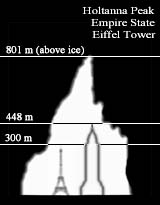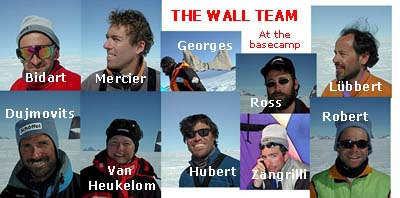|







©
photos
antarctica.org
Ronald Ross
René Robert
|


|






|
DISPATCHE
4 : 19 - 23 December

Saturday
Decembre 23rd : They won't climb the North pillar...
The decision came through
yesterday : the plan to climb the north pillar of the Holtanna Peak
is abandoned. Too risked, also too dangerous. On December 20th, Daniel
and Ralph were frightened quite a lot. At the time they 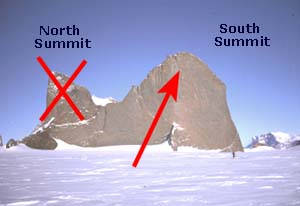 attempted
to find a safe way to the top, they met on the climbing one huge
inverted rock as large as a car which threatened to come off the cliff
and to cut the rope belaying them. No way to go no, both climbers
came back to the base camp. attempted
to find a safe way to the top, they met on the climbing one huge
inverted rock as large as a car which threatened to come off the cliff
and to cut the rope belaying them. No way to go no, both climbers
came back to the base camp.
Then a briefing took place
before they a ll return to the mountain, trying to discover a safer
itinerary towards summit. During these tasks, Hubert and Georges who
want to recover a part of the ropes still in place on the wall, found
the way so beautiful that they tried one more to progress. For the gesture
: "There is a beautiful candle which reaches up to half height of
the pillar", wrote Hubert in one of his messages send from the base
camp. "It would indeed be possible to climb up to the right, but
we leave that out until later…" Then coming down again, a small
disaster : one of the batteries of the drill slips from the chef's fingers
and crash 400 meter down.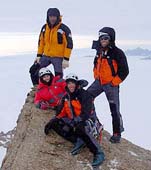
The day after, December 21st,
the decision was taken to climb the pillar along the normal way, (itinerary
followed by the Norwegians 7 years ago), actually over the hollow tooth,
much easier.
That is how, in a few hours climbing barely, all the climbers met
again on the summit. Fantastic panorama no need to say : the alpinists
could perceive in the distance Blue One station ! Hubert and Georges
decide than to bivouac up there, so as to attempt to come down the day
after, descending along the dangerous side and to asses the state of
the rock. Another small incident during this climbing : the loss of
one of the drill bits and the break of the other one. So come the expedition
to the point of being reduced to bore holes in the cliff by hand !
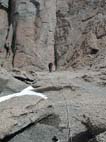 The
other ones descended without any problem and arrived at the base camp
around midnight. The morning after, Georges and Hubert tried to descent
over the rotten way with 40 kg in the rucksack. Alain Launched 100 meters
rope. But as it fell all over when he was slowly progressing, he had
to climb back up full speed ahead. The
other ones descended without any problem and arrived at the base camp
around midnight. The morning after, Georges and Hubert tried to descent
over the rotten way with 40 kg in the rucksack. Alain Launched 100 meters
rope. But as it fell all over when he was slowly progressing, he had
to climb back up full speed ahead.
That's why they decided
to abandon the idea of climbing the North summit and to go and try the
South summit. This climbing is maybe less dangerous and easier technically,
but this summit is also 200 m higher and much more exposed to the wind.
Another disadvantage results from its geographical position : the south
pillar is exposed to the sun only during evening and night time. The
climbers will thus be obliged to inverse their daily rhythm and start
climbing at 5 or 6 in the evening. Before they move to the south summit,
the climbers went back a last time to Holtanna North face in order to
recover the equipment left in the cliff. "I will nevertheless leave
250 meter rope on this face", said Alain. "One never
knows if Georges and I, after having reached our new goal, wouldn't
be tempted to come back to this rotten rock and see what we could do
about it…"

Friday,
22 December : What's Happening at the Foot of the Holtanna ?
Although it
could be true that all the great polar expeditions can be divided into
episodes, the one that is in the process of taking place at the foot
of the Holtanna could be called : The Mystery of the Great Pyramid.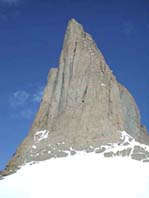
What
is rotten Granite?
The
granite of the Orvin Mountains (where the Holtanna is) is essentially
an extremely hard rock. But, given the severe conditions (cold,
wind, and freezing) to which these nunataks are exposed, their
external envelope has slowly become exfoliated with the passage
of time. The tangible effect of this on the ground (and this
is visible in the photograph published on the opposite page)
are surface sheets of rock which break away easily. We do not
have any more detailed information about the depth and size
of these crumbly slabs of rock; one does however realise much
more clearly that climbing on such a degraded surface requires
considerable thought. Which is undoubtedly what the men of The
Wall are giving it.
|
Tuesday : the big names made
an initial brief assault on the Holtanna and, instead of returning at
around 16.00 for tea as envisaged, they were seen to return to the base
camp at about noon. The reason? The same as the day before, but studied
on a far greater scale - no doubt they had climbed higher than their
team-mates had the day before. The rock is so rotten that a serious
meeting was called for.
A project briefing, in a way;
in the big tent (see the photograph
in the report below). We are
still not fully aware of what was said that  day,
the Tuesday afternoon. But what is certain, is that the next day several
scouts were sent by the one who adores the word "boss" to other places
at the foot of the rock face. day,
the Tuesday afternoon. But what is certain, is that the next day several
scouts were sent by the one who adores the word "boss" to other places
at the foot of the rock face.
The Holtanna, as perhaps you have read in the presentation of the expedition,
is in the shape of a hollow tooth (like a tooth with caries): the ascent
was envisaged on the outside.
On Wednesday, they went to look at the inside cirque to assess
the health of the rock there. They were talking, yesterday Thursday,
even of quickly climbing on that side (far easier), and coming down
again by abseiling along the rock face to study it in detail and at
their ease…
Since then,
no further news. Bidart has just sent us an interesting paper on collecting
lichen 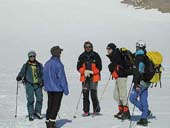 (see
below). But from the climbing point of view, this is not exactly the
kind of information that catches the imagination. Therefore, on this
Friday, 22 December, early in the morning, despite my searching the
horizon for e-mails, we are in neutral… (see
below). But from the climbing point of view, this is not exactly the
kind of information that catches the imagination. Therefore, on this
Friday, 22 December, early in the morning, despite my searching the
horizon for e-mails, we are in neutral…
Other news
later, no doubt.
 Wednesday
December 20th : "I did not feel entirely safe sleeping in my
tent on my own"...
Wednesday
December 20th : "I did not feel entirely safe sleeping in my
tent on my own"...
from Kahtelijne Van Heukelom (As Van Heukelom is not quite fluent
in English, this following text has still to be checked by our translator,
sorry...)
Description of our tents in
the base camp. There are 7 small tents and 2 big dome-tents (in the
middle there is an igloo (see thje photo) which houses the latrine).
They have room for 2 persons to sleep. All the tents are next to each
other with their openings facing north. Away from the direction of the
wind. The katabatic  winds are coming from southeast which is why we had to put the opening
of our tents facing the opposite direction.
winds are coming from southeast which is why we had to put the opening
of our tents facing the opposite direction.
The tents of course have to
be protected as much as possible. First of all there is the strengthening
of the tentropes. At the end of these ropes we hang an little bamboo
pole. When the ropes are taut we put this bamboo-stick horizontally
into the snow. We covered it with snow and ice. Because of the low temperature
here, everything is frozen quickly and there is no chance that these
tentropes will come loose with in storms or heavy winds.
For protecting the tents for katabatic storms and winds, yesterday we
have built ice-walls for every tent. They are about half a metre high.
Alain Hubert has the biggest
tent but he's the boss. He's sleeping alone and has a lot of space to
spread out all his papers. To his left, you can see the tent of Ronald
Ross, our specialist - a rescuer in need. His tent looks like a technical
laboratory. In between René, André and Jorge have built
a pyramid of ice ; this piece of Egyptian culture is necessary for the
solar 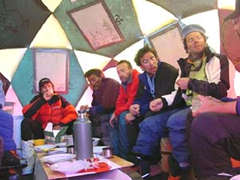 panels.
To the right of Alain' s tent is the tent of André and René.
René's tent is easily recognizable because there is a tripod
for his camera at tis entrance. He always goes to sleep with his camera
and wakes up with it. The next tent is the one for Ralf and myself.
Alain Hubert had planned, for the only female in the group, a single
tent. When thinking of the katabatic winds, the storms and my minimal
polar experience, I didn't feel very safe, alone in a tent. So an experienced
old man - Ralf - made the sacrifice. In the neighbouring tent, sleep
Bidart and Mercier. Do not walk too close at night, because Daniel goes
to bed quite early ! Jorge has a tent that is a little bit bigger than
the others : but he has to cope with all his camera material. As far
as Fabrizzio is concerned, he is sleeping alone, dreaming every night
of the most beautiful girl in the world : a blond aerobic teacher. panels.
To the right of Alain' s tent is the tent of André and René.
René's tent is easily recognizable because there is a tripod
for his camera at tis entrance. He always goes to sleep with his camera
and wakes up with it. The next tent is the one for Ralf and myself.
Alain Hubert had planned, for the only female in the group, a single
tent. When thinking of the katabatic winds, the storms and my minimal
polar experience, I didn't feel very safe, alone in a tent. So an experienced
old man - Ralf - made the sacrifice. In the neighbouring tent, sleep
Bidart and Mercier. Do not walk too close at night, because Daniel goes
to bed quite early ! Jorge has a tent that is a little bit bigger than
the others : but he has to cope with all his camera material. As far
as Fabrizzio is concerned, he is sleeping alone, dreaming every night
of the most beautiful girl in the world : a blond aerobic teacher.
Ronald Ross is responsible
for charging the batteries. A very important job because without the
energy of the batteries we can't do a thing. And we have as you may
guess numerous needs : for the computers, for the satellite, for sending
our information, for the camera. He has prepared a meticulous schedule
and so far till now everything is fine.works ok but I must mention that
every day we have had a beautiful weather and the sun was always there
to recharge the solar panels.
This
morning all the climbers - except Alain - went to the Holtanna to prepare
for the climb. Daniel and Ralf already start with a little climbing
experience. But they don't seem that happy. At
noon they all came back to the basecamp again, a bit discourageds. The
Holtanna seems to be more precarious than they had thought. Ralf, Daniel
and André are convinced that it would be dangerous to climb on
this side of the mountain. While drinking tea, the whole climbing team
discussed the situation. This afternoon they all went together with
Alain to search for another way to reach the top.

|


